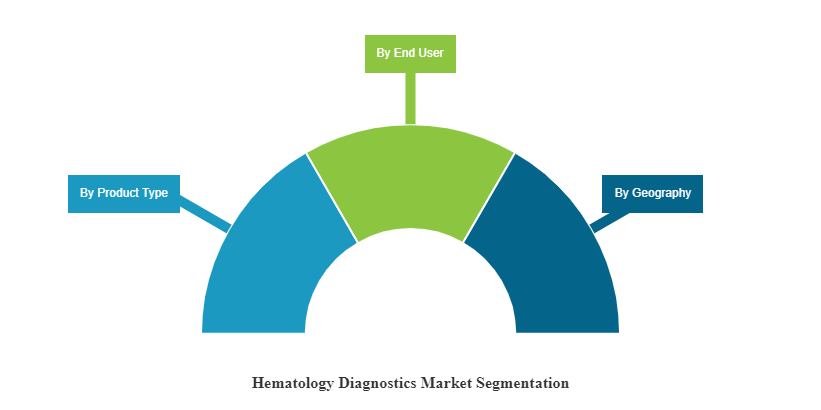Home / Healthcare / Hematology Diagnostics Market
Hematology Diagnostics Market Size, Share and Analysis by Type (Instruments, Consumables), By End User (Diagnostic Centers, Hospitals and Clinics, Academic and Research Institutions), and Regional Forecast, 2025-2032
Report Format: PDF | Published Date: Ongoing | Report ID: FBI100650 | Status : UpcomingHematology is the branch of medicine which deals with blood and blood disorders, thus hematology diagnostics help the medical professionals to diagnose and investigate potential blood disorders. Some of the examples of blood disorders include the various types of anemia, the several forms of blood cancer, thalassemia, malaria, hemophilia, deep venous thrombosis, von Willebrand disease amongst others.
The causes of blood disorders include genetic mutation, exposure to toxins, nutritional deficiency, infections, and other illnesses. Some of the diagnostic instruments include hematology analyzers, plasma protein analyzers, ESR analyzers, hemostasis analyzers, coagulation/ micro-coagulation analyzers. A number of factors are expected to contribute to the growth of the hematology diagnostics market. The Leukemia and Lymphoma Society has stated that leukemia, lymphoma, and myeloma are expected to account for 10% of the estimated 1,735,350 new cancer cases diagnosed in the U.S. in 2018.

Another prevalent class of blood disorders is anemia, which the World Health Organization (WHO) estimates affects about 40.1% of pregnant women globally. The growing incidences of blood disorders, the growth of health infrastructure in developing nations, the growing aging population, and technological advances are some of the factors expected to drive the market’s growth.
One of the key drivers of the growth in the market is the prevalence of hematology disorders especially the occurrence of a range of blood cancers such as leukemia and also the ability to detect the presence of inflammation in the body through the measurement of the Erythrocyte Sedimentation Rate (ESR). These factors are expected to considerably contribute to the growth of the market. Owing to the growth of factors which causes blood disorders such as mutation of genes, the heightened levels of pollution, the absence of essential nutrients in an individual and the rising instances of other illnesses, the market for hematology diagnostics is anticipated to grow.
The factor that is expected to inhibit the growth of the market is the limitations associated with the hematology diagnostics. The factors which limit the growth of the market include that not all the blood tests provide the final diagnosis of disease, they are only used to detect for abnormalities, the cost of diagnostic tests and the lack of insurance coverage.
Key Players Covered
Some of the major companies that are present in the global hematology diagnostics market are Beckman Coulter, Inc., Abbott, HORIBA, Ltd., Sysmex Corporation, Instrumentation Laboratory, Siemens AG, F. Hoffmann-La Roche Ltd., Bio-Rad Laboratories, Inc., HemoCue and Shenzhen Mindray Bio-Medical Electronics Co., Ltd. and other players.
SEGMENTATION
SEGMENTATION |
DETAILS |
By Type |
· Instruments o Analyzers o Fully Automated Analyzers o Semi-Automated Analyzers o Flow Cytometers o Others · Consumables |
By End User |
· Diagnostic Centers · Hospitals and Clinics · Academic and Research Institutions · Others |
By Geography |
· North America (USA and Canada) · Europe (UK, Germany, France, Italy, Spain, Scandinavia and Rest of Europe) · Asia Pacific (Japan, China, India, Australia, Southeast Asia and Rest of Asia Pacific) · Latin America (Brazil, Mexico and Rest of Latin America) · Middle East & Africa (South Africa, GCC and Rest of Middle East & Africa) |
At present, consumables account for the largest proportion of the market and this is not expected to change because it is one of the most used components in the hematology diagnostics. This is because it is utilized more for the diagnosis of increasing hematological disorders. Increasing demand for early detection and increasing volume of tests being undertaken are further increasing the growth.
Key Insights
- Prevalence of Blood Disorders and the Types of Disorder
- Advancements in research & development of hematology diagnostics
- Overview of diagnostic instruments used
- Recent industry developments such as partnerships, mergers, and acquisitions
- New Product Launches
- Pricing Analysis
Regional Analysis
The global hematology diagnostics market has been segmented into North America, Europe, Asia Pacific, Latin America, and Middle East & Africa. North America followed by Europe are the two largest markets for hematology diagnostics at present and they are expected to account for a large proportion of the market in the forecast period as well. This is due to the high prevalence of the hematological disorders in the region and also the ongoing research & development initiatives for the development of advanced diagnostics. In the Asia Pacific region, Japan is expected to provide the largest market opportunity. This is because Japan has a highly developed healthcare system and also a large proportion of the geriatric population. An emerging market such as India and China, are anticipated to fuel considerable market growth.
Key Industry Developments
- In February 2019, Horiba announced the launch of its D-Dimer hematology reagent for the Yumizen G hemostasis instruments - fully automatic (Yumizen G800, Yumizen G1500 & Yumizen G1550) and semi-automatic (Yumizen G200 & Yumizen G400)
- In May 2018, Beckman Coulter Diagnostics announced the launch of the new hematology software for the new and existing DxH 500 hematology analyzers
- In January 2018, Abbott announced the launch of its ALINITY H-SERIES INTEGRATED HEMATOLOGY SYSTEM equipped with greater accuracy, speed and seamless integration
- Global
- 2023
- 2019-2022


